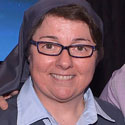Catholic Nun and Film Critic Finds God’s Grace at the Movies


Her background in media studies, along with the principles of Catholic Social Teaching, rooted in Scripture and Church teaching, provide her the inspiration to write and speak about cinema—inspiration, she says “practically erupts through whatever screen I am watching.”
Sister Rose has developed a significant following through her blogs and columns, as well as through a series of books with Fr. Peter Malone, MSH, called Lights, Camera, Faith. Her work is generally well-received, though some of her reviews—her characterization of The Passion of the Christ as a horror film or Millions as a Christmas story for families—have generated some controversy.
Sister Rose’s film writing illuminates the grace experienced through cinematic storytelling. Indeed, she helps us find God at the movies. For Sister Rose writing about film is a ministry.

Helping others experience this “sacramental quality” is what motivates Sister Rose. In 2007, she co-wrote a study guide for the film Into Great Silence, about the Carthusian monks, an austere silent order who live in the French Alps.
Sister Rose and Ron Schmidt, SJ, were inspired to write the guide by a comment published in National Catholic Reporter; a commenter could not understand how “such a rigid, controlled, isolated life could have anything to do with the life of grace.” This “exquisite question” was the starting point for the project, as it is for all of Sister Rose’s writing: “How to find God in the darkness.”
The film study guide includes background on the monastic tradition and the making of the film, as well as questions for discussion, and prayer and reflection for silent retreats. The guide shepherds the viewer’s experience of the film, drawing attention to the director’s approach of letting the camera linger on a scene so that the natural rhythm of life in the monastery can reveal itself.
The guide makes us aware of the absence of typical filmmaking conventions, including the usual barrage of images and sounds, a musical score, special effects, or voiceover. This absence allows us to experience the grace of the monks’ existence and their deliberate surrender to the unmediated presence of God.
The mindfulness required by the monastic life mirrors Sister Rose’s own path. The purpose of her writing life was brought into sharp focus when she was diagnosed with multiple sclerosis (MS), which she says opened up a way for her “to write and communicate about media mindfulness.”
“Whatever I do is an expression of the fruitfulness of my life,” she said. “Indeed, the very fruit of my life, and I pray this communications ministry will assure people, more than anything else, that God loves them and that there is always hope.”
Watch the trailer for “Into Great Silence.

